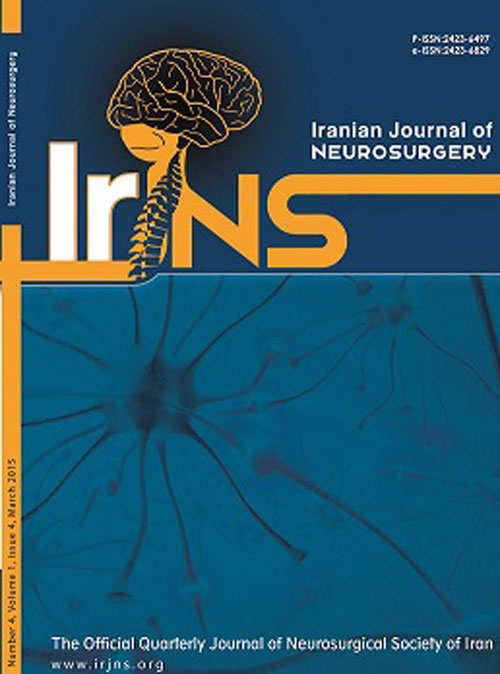فهرست مطالب

Iranian Journal of Neurosurgery
Volume:3 Issue: 2, Spring 2017
- تاریخ انتشار: 1396/05/30
- تعداد عناوین: 5
-
-
Pages 39-50Background And AimDegenerative lumbar scoliosis is a spinal deformity resulting from advanced disc degeneration and facet arthropathy. Given the inconclusive available literature and lack of high-quality data supporting the role of minimally invasive surgical management of degenerative lumbar scoliosis, this review intends to highlight and compare the various viable minimally invasive surgical methods for adult degenerative deformity correction.
Methods and Materials/Patients: Online databases search including Medline, PubMed and Ovid was preformed using the keywords: adult, degenerative, lumbar scoliosis, etiology, clinical issues, diagnostic imaging, spinopelvic alignment, non-operative and surgical treatment options, minimally invasive, interbody fusion, and percutaneous pedicle screw fixation. Eighty-three studies, published after 2000, on degenerative lumbar scoliosis epidemiology, classification and management were identified and reviewed.ResultsMinimally invasive surgical techniques available for interbody fusion include posterior lumbar interbody fusion, transformational lumbar interbody fusion, oblique lumbar interbody fusion, anterior lumbar interbody fusion, and extreme lateral interbody fusion. Each surgical option warrants technical considerations, indication, complications awareness, and functional and radiological outcomes assessment. Sound patients selection is key for improved outcomes, and therefore the following factors should be well examined prior to surgical intervention: the patients medical condition and underlying morbidities, the extent of the involved disc spaces, imaging characteristics, and surgeon skills.ConclusionThe superiority of one surgical technique over the others, was not proven due to lack of strong and supportive data. However, a comprehensive review of indications, benefits, and disadvantages of the minimally invasive surgical procedures is presented. There is an interest in minimally invasive surgery of the spine owing to lower complication rates and morbidity, with limited soft tissue disturbance, decreased blood loss, improved cosmesis, shorter hospital stay, earlier return to work, and therefore decreased general health care costs.Keywords: Lumbar, Degenerative, Scoliosis, Minimally Invasive, Surgical Procedures -
Pages 51-57Background And AimTraumatic brain injury is one of the leading causes of mortality and disability in young adults. Epigallocatechin-3-gallate, the antioxidant compound of green tea, has been proposed to have antioxidant and anti-inflammatory properties. This study evaluates the potential effects of epigallocatechin-3-gallate on the early clinical outcome and serum S100B levels (biomarker for brain tissue damage severity) in patients with moderate to severe traumatic brain injury.
Methods and Materials/Patients: Thirty patients with moderate to severe traumatic brain injury admitted to the intensive care unit were enrolled. The patients were randomly allocated to treatment with either a daily oral dose of 400 mg epigallocatechin-3-gallate or placebo (distilled water) for seven days. The main outcome measures were duration of mechanical ventilation and ICU stay, Glasgow Coma Scale, and S100B protein level.ResultsThe results revealed a significant improvement in consciousness level after seven days in the epigallocatechin-3-gallate group (2.93±3.9 unit improvement in GCS versus 0.14±3.05 reduction in GCS, p-value:0.033). There was also a significantly shorter duration of mechanical ventilation in the epigallocatechin-3-gallate compared to the control group (5.1 days versus 9.8 days, p-value:0.02). Reduction of the serum S100B level was slightly higher in the epigallocatechin-3-gallate group (23.96 versus 18.6 pg/ml) but the difference was not statistically significant.ConclusionEpigallocatechin-3-gallate supplementation had beneficial effects on consciousness level of the patients with moderate to severe traumatic brain injury in the acute phase.Keywords: Epigallocatechin-3-gallate, Head Trauma, Neuroprotection, S100B Protein, Traumatic Brain Injury -
Pages 58-62Background and Importance: Overdrainage is a complication of ventriculoperitoneal shunt but adjustable valves and anti-siphon devices can prevent it. These very expensive valves are most often inaccessible, so that the majority of the valves available in Togo are fixed differential pressure valves. Although overdrainage is a widely-known issue, we aimed to introduce a new risk factor and the way we manage this complication.Case PresentationThis case series study included all patients who had overdrainage or a high potential risk of overdrainage (hydranencephaly). Our technique consisted of partial ligation of the peritoneal catheter at the level of the thorax by non-resorbable wire while controlling the drainage rate at the slots. The goal was to transform this fixed differential pressure valve into a pressure-controlled and flow-regulated one. Patients were followed for 1, 3 and 6 months, postoperatively.
ConclusionHydranencephaly predisposes patients to overdrainage. The partial ligature of the catheter is an effective technique for treating or preventing overdrainage.Keywords: Overdrainage, Ligation, Catheter -
Pages 73-77Background and Importance: This interesting case is about the presence of normal pressure hydrocephalus and a large pseudomeningocele at the same time after 13 months of posterior fossa surgery. Although the occurrence of a pseudomeningocele following posterior fossa surgery is not so rare, such a late large pseudomeningocele development with signs and symptoms of NPH after 13 months of surgery is rather peculiar.Case PresentationA 59-year-old man referred to our clinic for a cerebellopontine angle tumor. The patient presented with right hearing loss and mild facial palsy. We operated the patient with retrosigmoid approach, and we discharged him after five days. After about 13 months, the patient referred to our center again with complaint of progressive bulging of previous surgical region and gait apraxia, urinary incontinence and dementia. A large pseudomeningocele in the site of previous surgery was seen.ConclusionThe authors presented a case report on late development (13 months) of a huge pseudomeningocele following vestibular schwannoma surgery with signs and symptoms of normal pressure hydrocephalus. Such a late big pseudomeningocele presentation with signs and symptoms of normal pressure hydrocephalus after posterior fossa surgery is peculiar.Keywords: Hydrocephalus, Pseudomeningocele, Intracranial, Pressure

